© 2023 Dr Margaret Sheppard
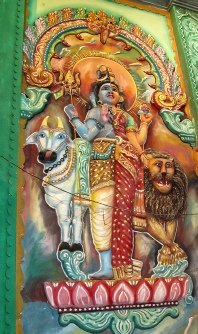
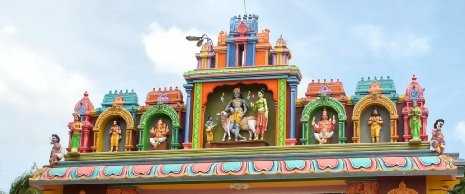
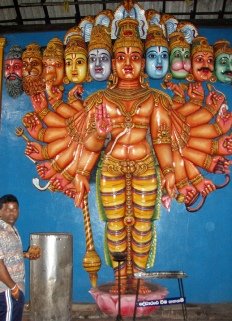
Examples of images of Deities depicted in Sri Lankan Temples.
Here only brief details are given about Sri Lankan Deities and the focus is upon the main Deities and their legends that form parts of the Tovil Ceremonies, especially the Pattini Ceremonies. As will be seen in these sections the dances, mimes and songs refer to these legends. More detailed descriptions of the Deities are easily accessible on Internet. Wikepaedia is an excellent starting point and has many references for a more comprehensive study of Deities. There is an excellent article “The Gods and Deity Worship in Sri Lanka” on WWW Virtual Library -
Although many of these Deities are of Hindu Indian origin, the Sri Lankan Buddhists have incorporated them into their practices (although strict Buddhists condemn this incorporation as heretical). However Deities are popularly regarded as being faithful Buddhists and Guardians of the The Three Refuges -
(Humans can also be vulnerable to evil influences from demons and their unfavourable horoscopes influenced by unfavourable positioning of the planetary Deities affecting their horoscope at particular times. (Astrologists are consulted and cast an individual’s horoscope at birth and at other important stages -
None of the Deities are regarded as superior to or in any way equal to Buddha. Whereas Buddha has achieved Nirvana/Enlightenment and thus is released from constant rebirths, the Deities are still striving to achieve this state through their faithful following and protection of Lord Buddha’s teachings.
Deities are superior to human beings as they have either been born in a higher plane or have become deified following great heroic acts in ancient times whilst they lived as human. Thus they are believed to be in a position to assist humans in times of their difficulty much in the way a “superior” person helps an “inferior” and in so doing gains merit and moves closer to the ultimate Buddhist goal of Nirvana. In their role as Guardians of the Buddhist religion, Deities inflict punishments on humans for misdeeds or transgressions.
As already stated, Deities are believed to be below Buddha but superior to Humans. Demons are inferior to Humans. Deities are believed to be capable of helping human beings in times of their troubles, but punishing them for transgressions. In this role of administering punishments, they can be attributed as a cause of diseases, illnesses and misfortunes. If Deities are deemed as the cause of illness or misfortunes, then certain steps in the form of ceremonies, may well require to be taken by the sufferer(s).
Assistance from Deities is commonly sought via their Shrines (Devalyas) sited in earthly abodes of the Deities, via the Shrines’ Priests or Guardians called Kapuralas. These Shrines are found not only in the Deity’s main temple but also in Sri Lankan Buddhist Temples where there will be separate shrines to different Deities. Shrines to Deities are also found along the roadsides, where travellers make offerings to ensure a safe journey. Different Deities are attributed with being responsible for different aspects of human life.
Supplicants seeking assistance from a Deity typically approach the Deity with their problem via the Shrine Guardian who acts as an intermediary. The appropriate offerings include vegetarian foods, fruits, flowers, money, gold and silver, cloth, coconuts etc. These are presented to the Deity arranged attractively in offering baskets. These offerings may be purchased from stalls around the Shrine or brought from home. The Shrine Guardian takes these offerings from the supplicant to the inner part of the shrine and addresses their request to the Deity in the appropriate and respectful manner. He then returns part of the offering foods and basket to the supplicant who will then share it with others – this is believed to be holy food and imbued with some of the essence of the Deity.
When they petition a Deity for assistance in times of trouble a supplicant may make a vow to the Deity to be honoured on successful removal of the problem and/or when they are cured. Examples of these vows are: feeding poor people and/or monks, providing refreshments for travellers along the roadside or on Pilgrimage routes, donating to a Temple, going on pilgrimages, or perhaps more penitential acts such as walking on nails, being suspended by hooks fixed through the skin, lips or cheeks pierced with metal mini lances, rolling or crawling all the way in a perahera procession etc. or Kavadi (see section on Kataragama).
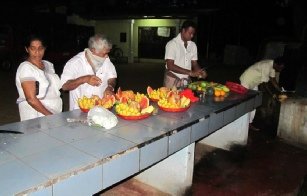
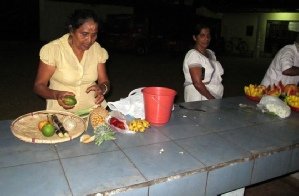
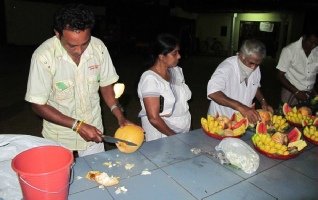
Readymade Offering baskets, coconuts etc. may be bought from the many stalls outside the temple shrines . The vendors will also make them up and arrange them according to the supplicant’s selected choice of fruits and offering etc.
Alternatively many people prefer to make up their own on the preparation tables provided inside the temples. N.B. The very devout pilgrim who has covered his mouth to prevent polluting the offerings for the Deity.
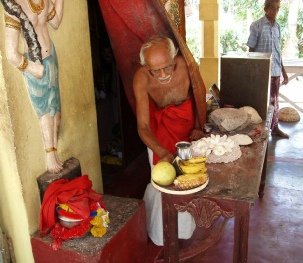
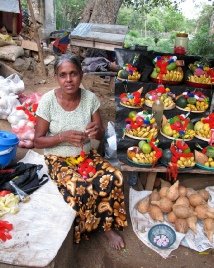
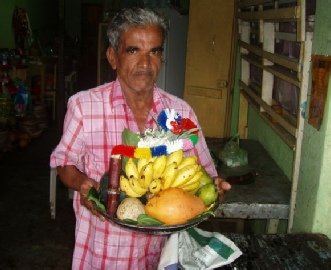
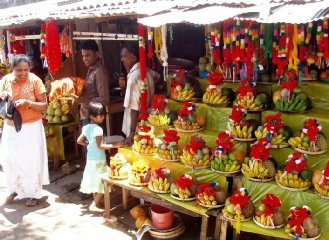
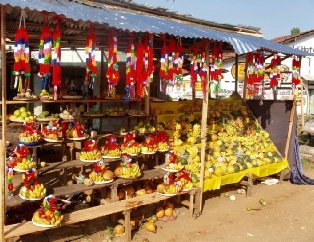
Temple Art inside a Hindu Temple on the Jaffna Peninsula illustrating Deities

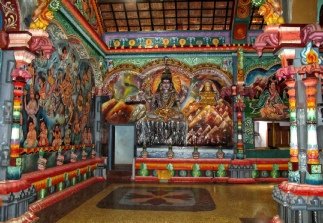
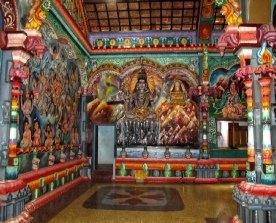
These pictures painted on the walls and ceilings depict different stories of the Deities
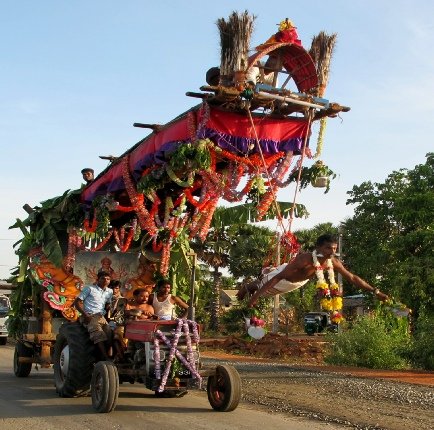
Fulfilling a vow made to a Deity. N.B. the man suspended from the front of the tractor by hooks fixed through his skin. He was then driven in a procession along this road on the East Coast to fulfil a vow made to a Deity -
As already noted in addition to helping humans in times of their troubles the Deities are responsible for punishing transgressions. Bad luck, epidemics, famine, crop failures, droughts, floods etc. can all be attributed to punishments from the Deities. However it should be noted that the Deities are not commonly believed to inflict these punishments directly but send their attendants (assigned demons or minor Deities) to inflict these on their behalf.
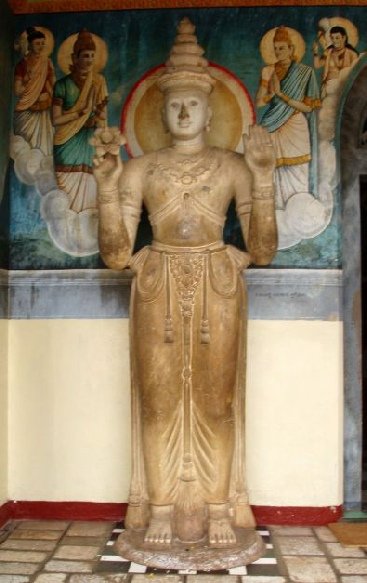

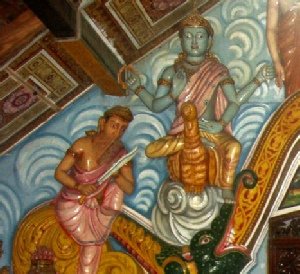
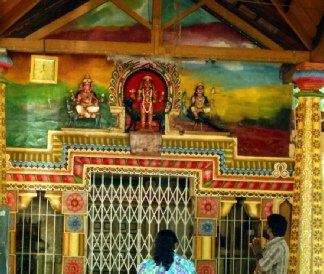
Main Duties of the Shrine Kapuralas/Priests/Guardians
The main duties of the shrine guardians/priests (kapuralas) involve caring for the shrines under their charge, performing the prescribed rituals, and approaching the Deity on behalf of supplicants. They do this by entering the inner shrine with the offerings and requests brought by the devotees. The guardian is given a fee for his services by the supplicant. For the Guardians of most of the village Shrines this provides a part time income which supplements their normal occupation (e.g.fisherran, paddyfield worker etc.). In addition they may officiate at the special Ceremonies held for the Deities. (See sections on Pattini Ceremonies).
Once the ritual is over, a part of the food offering is returned to the supplicant to share with others as it is believed to have sacred value. The offerings normally consist of milk-
Typically, the supplicant tells the guardian of the shrine their request to the Deity and presents their offering to him to make their request in the formal and appropriate manner to the Deity. The guardian takes the offering inside and addresses the Deity directly in front of their statue in the correct manner, whilst the supplicant waits respectfully outside. Then he returns from the inner room and blesses the supplicant(s) by placing a white mark with his thumb on their forehead(s).
The Deities believed to be in a Hierarchy. Those higher in the Hierarchy are those considered to have moved further towards the state of Nirvana in which Lord Buddha is situated are less involved in human affairs than those who are not so close to achieving Nirvana. It is the latter who are commonly approached for assistance by supplicants. The Deities are believed to punish wrongdoers probably indirectly via their assistants and the demons assigned to them to carry out their punitive instructions.